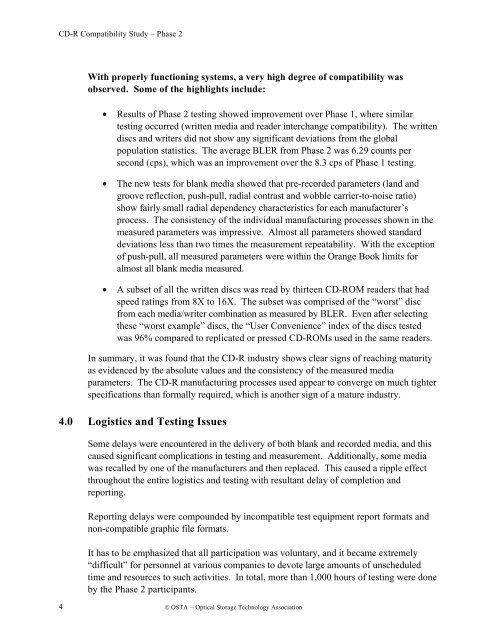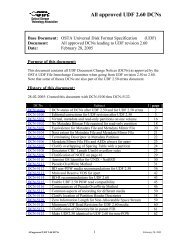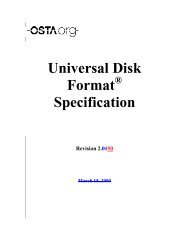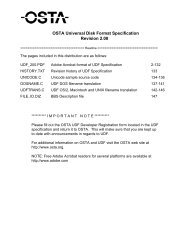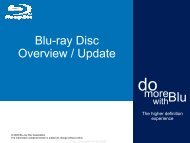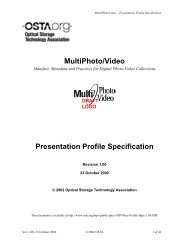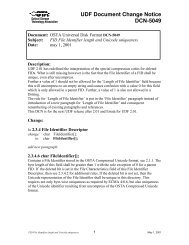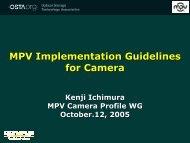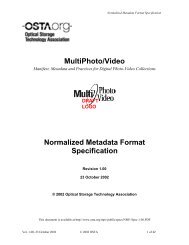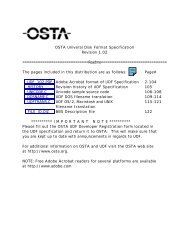osta cd-r compatibility study results from phase 2 - OSTA - Optical ...
osta cd-r compatibility study results from phase 2 - OSTA - Optical ...
osta cd-r compatibility study results from phase 2 - OSTA - Optical ...
You also want an ePaper? Increase the reach of your titles
YUMPU automatically turns print PDFs into web optimized ePapers that Google loves.
CD-R Compatibility Study – Phase 2<br />
With properly functioning systems, a very high degree of <strong>compatibility</strong> was<br />
observed. Some of the highlights include:<br />
• Results of Phase 2 testing showed improvement over Phase 1, where similar<br />
testing occurred (written media and reader interchange <strong>compatibility</strong>). The written<br />
discs and writers did not show any significant deviations <strong>from</strong> the global<br />
population statistics. The average BLER <strong>from</strong> Phase 2 was 6.29 counts per<br />
second (cps), which was an improvement over the 8.3 cps of Phase 1 testing.<br />
• The new tests for blank media showed that pre-recorded parameters (land and<br />
groove reflection, push-pull, radial contrast and wobble carrier-to-noise ratio)<br />
show fairly small radial dependency characteristics for each manufacturer’s<br />
process. The consistency of the individual manufacturing processes shown in the<br />
measured parameters was impressive. Almost all parameters showed standard<br />
deviations less than two times the measurement repeatability. With the exception<br />
of push-pull, all measured parameters were within the Orange Book limits for<br />
almost all blank media measured.<br />
• A subset of all the written discs was read by thirteen CD-ROM readers that had<br />
speed ratings <strong>from</strong> 8X to 16X. The subset was comprised of the “worst” disc<br />
<strong>from</strong> each media/writer combination as measured by BLER. Even after selecting<br />
these “worst example” discs, the “User Convenience” index of the discs tested<br />
was 96% compared to replicated or pressed CD-ROMs used in the same readers.<br />
In summary, it was found that the CD-R industry shows clear signs of reaching maturity<br />
as evidenced by the absolute values and the consistency of the measured media<br />
parameters. The CD-R manufacturing processes used appear to converge on much tighter<br />
specifications than formally required, which is another sign of a mature industry.<br />
4.0 Logistics and Testing Issues<br />
Some delays were encountered in the delivery of both blank and recorded media, and this<br />
caused significant complications in testing and measurement. Additionally, some media<br />
was recalled by one of the manufacturers and then replaced. This caused a ripple effect<br />
throughout the entire logistics and testing with resultant delay of completion and<br />
reporting.<br />
Reporting delays were compounded by incompatible test equipment report formats and<br />
non-compatible graphic file formats.<br />
It has to be emphasized that all participation was voluntary, and it became extremely<br />
“difficult” for personnel at various companies to devote large amounts of unscheduled<br />
time and resources to such activities. In total, more than 1,000 hours of testing were done<br />
by the Phase 2 participants.<br />
4 © <strong>OSTA</strong> – <strong>Optical</strong> Storage Technology Association


